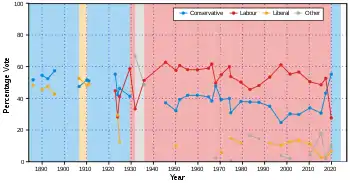Bassetlaw (UK Parliament constituency)
Bassetlaw /ˈbæsɪtˌlɔː/ is a parliamentary constituency[n 1] in Nottinghamshire, represented in the House of Commons of the UK Parliament since the 2019 general election by Brendan Clarke-Smith, a Conservative.[n 2] Before that election, the seat had been part of the so-called "red wall", being held by the Labour Party since 1929.
| Bassetlaw | |
|---|---|
| County constituency for the House of Commons | |
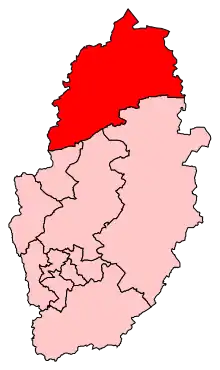 Boundary of Bassetlaw in Nottinghamshire for the 2010 general election | |
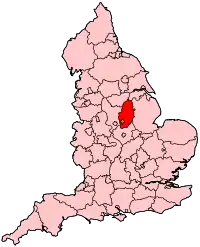 Location of Nottinghamshire within England | |
| County | Nottinghamshire |
| Population | 103,808 (2011 census)[1] |
| Electorate | 78,306 (December 2010)[2] |
| Major settlements | Worksop and Retford |
| Current constituency | |
| Created | 1885 |
| Member of Parliament | Brendan Clarke-Smith (Conservative) |
| Number of members | One |
| Created from | North Nottinghamshire |
Constituency profile
The Bassetlaw constituency is mostly rural and covers the north of Nottinghamshire, including the towns of Worksop and Retford. It shares the name with the Bassetlaw district. Parts of the constituency are former coal mining areas.
Boundaries
The constituency includes 22 electoral wards from Bassetlaw District Council:
- Beckingham, Blyth, Carlton, Clayworth, East Retford East, East Retford North, East Retford South, East Retford West, Everton, Harworth, Langold, Misterton, Ranskill, Sturton, Sutton, Welbeck, Worksop East, Worksop North, Worksop North East, Worksop North West, Worksop South, Worksop South East.
Latest boundary changes
Following their review of parliamentary boundaries in Nottinghamshire, the Boundary Commission for England made changes to the constituency for the 2010 general election to allow for population changes, most noticeably by moving the small town of Market Warsop into Mansfield constituency.
History
The constituency was created in 1885 by the Redistribution of Seats Act.
History of boundaries
The Bassetlaw Division (named after one of the ancient Wapentakes of the county) as originally created in 1885 consisted of the municipal borough of East Retford, the petty sessional divisions of Retford and Worksop and part of Mansfield petty sessional division.
In 1918, the number of parliamentary divisions in Nottinghamshire was increased from four to five, with resulting changes in boundaries. Bassetlaw Division was now defined as containing the Municipal Borough of East Retford, the Urban Districts of Warsop and Worksop, and the Rural Districts of Blyth & Cuckney, Misterton and East Retford, with the civil parish of Sookholme from Skegby Rural District.
In 1950, the five Parliamentary Divisions of Nottinghamshire were reorganised as six County Constituencies. Local government boundary changes in the 1930s now meant that Bassetlaw County Constituency was defined as comprising the Municipal Boroughs of East Retford and Worksop, the Urban District of Warsop and the Rural Districts of East Retford and Worksop.
The constituency's boundaries then remained unchanged until 1983. In that year, the town of East Retford and the neighbouring areas were transferred to the redrawn Newark constituency. Bassetlaw constituency then comprised Worksop and surrounding areas in the Bassetlaw district as well as the town of Warsop in the Mansfield district (see list of wards during this period below). There were no boundary changes in 1997.
From 1983 to 2010, the constituency comprised the following Bassetlaw district wards:
- Beckingham, Blyth, Carlton, Clayworth, Everton, Harworth East, Harworth West, Hodsock, Misterton, Rampton, Ranskill, Sturton, Sutton, Welbeck, Worksop East, Worksop North, Worksop North East, Worksop North West, Worksop South, Worksop South East
along with two Mansfield district wards:
- Birklands, Meden (both in the Warsop area). These wards were transferred to Mansfield constituency in 2010.
Bassetlaw constituency boundaries, shown within the county of Nottinghamshire
 1885 to 1918
1885 to 1918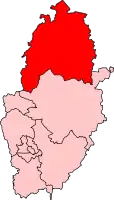 1950 to 1983
1950 to 1983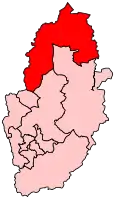 1983 to 2010
1983 to 2010 Since 2010
Since 2010
Electoral history
On a historical measure, this had been a very safe seat for the Labour Party before 2019, with their own or related candidates having held it since the 1929 general election. On a size-of-majority measure, it was a low to medium safe seat. Its first Member of Parliament Malcolm MacDonald was one of the few Labour MPs to join his father Ramsay MacDonald's National Government. MacDonald held the seat as a National Labour candidate in the 1931 election, but was defeated at the next election in 1935 by Labour's Frederick Bellenger.
Bellenger held the seat until he died in 1968. A by-election followed. The seat was retained for the Labour Party by Joe Ashton with a slender 1.72% majority, the narrowest since the 1920s. He held the seat until retirement at the 2001 general election. He was succeeded at that year's election by fellow Labour politician John Mann, who retained the seat at the next four elections. In 2019, Mann resigned being having been appointed to head a government inquiry on tackling anti-Semitism and to take a seat in the House of Lords.[3] The Labour candidate initially chosen to replace Mann, Sally Gimson, was deselected before the election by the party's National Executive Committee over what were described as "very serious allegations".[4] Gimson referred to the process as a "kangaroo court", and Mann called the decision a stitch-up;[4] Gimson started legal action against the party, but dropped the case several days later.[5] Keir Morrison, a councillor in the Ashfield District, replaced Gimson as the Labour candidate.[6]
In the December 2019 general election, the Conservatives won the seat with a swing from Labour of 18.4%, the largest recorded in the election.[7] The fall in Labour's vote, 24.9%, was the greatest of any seat in the election.[8]
Members of Parliament
Elections
Elections in the 2010s
| Party | Candidate | Votes | % | ±% | |
|---|---|---|---|---|---|
| Conservative | Brendan Clarke-Smith | 28,078 | 55.2 | ||
| Labour | Keir Morrison | 14,065 | 27.7 | ||
| Brexit Party | Debbie Soloman | 5,366 | 10.6 | ||
| Liberal Democrats | Helen Tamblyn-Saville | 3,332 | 6.6 | ||
| Majority | 14,013 | 27.5 | |||
| Turnout | 50,841 | 63.5 | |||
| Conservative gain from Labour | Swing | ||||
| Party | Candidate | Votes | % | ±% | |
|---|---|---|---|---|---|
| Labour | John Mann | 27,467 | 52.6 | +4.0 | |
| Conservative | Annette Simpson | 22,615 | 43.3 | +12.6 | |
| Liberal Democrats | Leon Duveen | 1,154 | 2.2 | −0.5 | |
| Independent | Nigel Turner | 1,014 | 1.9 | New | |
| Majority | 4,852 | 9.3 | −8.6 | ||
| Turnout | 52,250 | 66.5 | +2.9 | ||
| Labour hold | Swing | −4.3 | |||
| Party | Candidate | Votes | % | ±% | |
|---|---|---|---|---|---|
| Labour | John Mann | 23,965 | 48.6 | −1.9 | |
| Conservative | Sarah Downes | 15,122 | 30.7 | −3.2 | |
| UKIP | Dave Scott | 7,865 | 16.0 | +12.4 | |
| Liberal Democrats | Leon Duveen | 1,331 | 2.7 | −8.5 | |
| Green | Kristopher Wragg | 1,006 | 2.0 | New | |
| Majority | 8,843 | 17.9 | +1.3 | ||
| Turnout | 49,289 | 63.6 | −1.2 | ||
| Labour hold | Swing | +0.7 | |||
| Party | Candidate | Votes | % | ±% | |
|---|---|---|---|---|---|
| Labour | John Mann | 25,018 | 50.5 | −2.5 | |
| Conservative | Keith Girling | 16,803 | 33.9 | −1.2 | |
| Liberal Democrats | David Dobbie | 5,570 | 11.2 | −2.4 | |
| UKIP | Andrea Hamilton | 1,779 | 3.6 | New | |
| Independent | Graham Whitehurst | 407 | 0.8 | New | |
| Majority | 8,215 | 16.6 | −10.3 | ||
| Turnout | 49,577 | 64.8 | +6.7 | ||
| Labour hold | Swing | −5.1 | |||
Elections in the 2000s
| Party | Candidate | Votes | % | ±% | |
|---|---|---|---|---|---|
| Labour | John Mann | 22,847 | 56.6 | +1.3 | |
| Conservative | Jonathan Sheppard | 12,010 | 29.8 | −0.4 | |
| Liberal Democrats | David Dobbie | 5,485 | 13.6 | +0.9 | |
| Majority | 10,837 | 26.8 | +1.7 | ||
| Turnout | 40,342 | 58.1 | +1.3 | ||
| Labour hold | Swing | +0.9 | |||
| Party | Candidate | Votes | % | ±% | |
|---|---|---|---|---|---|
| Labour | John Mann | 21,506 | 55.3 | −5.8 | |
| Conservative | Alison Holley | 11,758 | 30.2 | +5.5 | |
| Liberal Democrats | Neil Taylor | 4,942 | 12.7 | +2.4 | |
| Socialist Labour | Kevin Meloy | 689 | 1.8 | New | |
| Majority | 9,748 | 25.1 | −11.3 | ||
| Turnout | 38,895 | 56.8 | −13.6 | ||
| Labour hold | Swing | −5.5 | |||
Elections in the 1990s
| Party | Candidate | Votes | % | ±% | |
|---|---|---|---|---|---|
| Labour | Joe Ashton | 29,298 | 61.1 | +7.7 | |
| Conservative | Martyn Cleasby | 11,838 | 24.7 | −10.3 | |
| Liberal Democrats | Mike Kerringan | 4,950 | 10.3 | −1.3 | |
| Referendum | Roy Graham | 1,838 | 3.8 | New | |
| Majority | 17,460 | 36.4 | +18.0 | ||
| Turnout | 47,924 | 70.4 | −9.0 | ||
| Labour hold | Swing | +9.0 | |||
| Party | Candidate | Votes | % | ±% | |
|---|---|---|---|---|---|
| Labour | Joe Ashton | 29,061 | 53.4 | +5.3 | |
| Conservative | Caroline Spelman | 19,064 | 35.0 | −2.5 | |
| Liberal Democrats | Mike J. Reynolds | 6,340 | 11.6 | −2.8 | |
| Majority | 9,997 | 18.4 | +7.8 | ||
| Turnout | 54,465 | 79.4 | +1.8 | ||
| Labour hold | Swing | +3.9 | |||
Elections in the 1980s
| Party | Candidate | Votes | % | ±% | |
|---|---|---|---|---|---|
| Labour | Joe Ashton | 25,385 | 48.10 | +2.50 | |
| Conservative | David Selves | 19,772 | 37.47 | −0.27 | |
| Alliance | William Smith | 7,616 | 14.43 | −2.23 | |
| Majority | 5,613 | 10.64 | +2.78 | ||
| Turnout | 52,773 | 77.56 | +3.38 | ||
| Labour hold | Swing | +1.39 | |||
| Party | Candidate | Votes | % | ±% | |
|---|---|---|---|---|---|
| Labour | Joe Ashton | 22,231 | 45.60 | ||
| Conservative | M Cleasby | 18,400 | 37.74 | ||
| Alliance | B Withnall | 8,124 | 16.66 | ||
| Majority | 3,831 | 7.86 | |||
| Turnout | 48,755 | 74.18 | |||
| Labour hold | Swing | ||||
Elections in the 1970s
| Party | Candidate | Votes | % | ±% | |
|---|---|---|---|---|---|
| Labour | Joe Ashton | 29,426 | 50.23 | ||
| Conservative | DK Harris | 22,247 | 37.97 | ||
| Liberal | A Wilkinson | 6,913 | 11.80 | ||
| Majority | 7,179 | 12.26 | |||
| Turnout | 58,586 | 79.42 | |||
| Labour hold | Swing | ||||
| Party | Candidate | Votes | % | ±% | |
|---|---|---|---|---|---|
| Labour | Joe Ashton | 28,663 | 53.69 | ||
| Conservative | DK Harris | 16,494 | 30.90 | ||
| Liberal | A Wilkinson | 7,821 | 14.65 | ||
| The Christian Party | A Storkey | 408 | 0.76 | New | |
| Majority | 12,169 | 22.79 | |||
| Turnout | 53,386 | 74.43 | |||
| Labour hold | Swing | ||||
| Party | Candidate | Votes | % | ±% | |
|---|---|---|---|---|---|
| Labour | Joe Ashton | 33,724 | 59.99 | ||
| Conservative | RC Heading | 22,490 | 40.01 | ||
| Majority | 11,234 | 19.98 | |||
| Turnout | 56,214 | 79.05 | |||
| Labour hold | Swing | ||||
| Party | Candidate | Votes | % | ±% | |
|---|---|---|---|---|---|
| Labour | Joe Ashton | 28,959 | 54.87 | ||
| Conservative | Jim Lester | 20,698 | 39.21 | ||
| Liberal | Malcolm Anthony Haydon-Baillie | 3,125 | 5.92 | New | |
| Majority | 8,261 | 15.66 | |||
| Turnout | 52,782 | 76.44 | |||
| Labour hold | Swing | ||||
Elections in the 1960s
| Party | Candidate | Votes | % | ±% | |
|---|---|---|---|---|---|
| Labour | Joe Ashton | 21,394 | 49.64 | −11.99 | |
| Conservative | Jim Lester | 20,654 | 47.92 | +9.55 | |
| Independent | Thomas Lynch | 1,053 | 2.44 | New | |
| Majority | 740 | 1.72 | −21.56 | ||
| Turnout | 43,101 | ||||
| Labour hold | Swing | ||||
| Party | Candidate | Votes | % | ±% | |
|---|---|---|---|---|---|
| Labour | Frederick Bellenger | 27,623 | 61.63 | ||
| Conservative | Robert William Martin Orme | 17,195 | 38.37 | ||
| Majority | 10,428 | 23.26 | |||
| Turnout | 44,818 | 73.29 | |||
| Labour hold | Swing | ||||
| Party | Candidate | Votes | % | ±% | |
|---|---|---|---|---|---|
| Labour | Frederick Bellenger | 27,612 | 59.03 | ||
| Conservative | Robert William Martin Orme | 19,167 | 40.97 | ||
| Majority | 8,445 | 18.06 | |||
| Turnout | 46,779 | 77.00 | |||
| Labour hold | Swing | ||||
Elections in the 1950s
| Party | Candidate | Votes | % | ±% | |
|---|---|---|---|---|---|
| Labour | Frederick Bellenger | 27,875 | 58.03 | ||
| Conservative | Maurice Cowling | 20,162 | 41.97 | ||
| Majority | 7,713 | 16.06 | |||
| Turnout | 48,037 | 80.19 | |||
| Labour hold | Swing | ||||
| Party | Candidate | Votes | % | ±% | |
|---|---|---|---|---|---|
| Labour | Frederick Bellenger | 26,873 | 58.11 | ||
| Conservative | Kathleen Voilet Maiden | 19,375 | 41.89 | ||
| Majority | 7,498 | 16.22 | |||
| Turnout | 46,248 | 79.46 | |||
| Labour hold | Swing | ||||
| Party | Candidate | Votes | % | ±% | |
|---|---|---|---|---|---|
| Labour | Frederick Bellenger | 32,850 | 60.71 | ||
| Conservative | William Sime | 21,257 | 39.29 | ||
| Majority | 11,593 | 21.42 | |||
| Turnout | 54,107 | 84.36 | |||
| Labour hold | Swing | ||||
| Party | Candidate | Votes | % | ±% | |
|---|---|---|---|---|---|
| Labour | Frederick Bellenger | 31,589 | 57.64 | ||
| Conservative | John James Cawdell Irving | 17,622 | 32.16 | ||
| Liberal | William GE Dyer | 5,590 | 10.20 | New | |
| Majority | 13,967 | 25.48 | |||
| Turnout | 54,801 | 87.15 | |||
| Labour hold | Swing | ||||
Election in the 1940s
| Party | Candidate | Votes | % | ±% | |
|---|---|---|---|---|---|
| Labour | Frederick Bellenger | 30,382 | 62.79 | ||
| Conservative | Robert Laycock | 18,005 | 37.21 | ||
| Majority | 12,377 | 25.58 | |||
| Turnout | 48,387 | 76.75 | |||
| Labour hold | Swing | ||||
Election in the 1930s
| Party | Candidate | Votes | % | ±% | |
|---|---|---|---|---|---|
| Labour | Frederick Bellenger | 21,903 | 51.33 | ||
| National Labour | Malcolm MacDonald | 20,764 | 48.67 | ||
| Majority | 1,139 | 2.66 | N/A | ||
| Turnout | 42,667 | 79.87 | |||
| Labour gain from National Labour | Swing | ||||
| Party | Candidate | Votes | % | ±% | |
|---|---|---|---|---|---|
| National Labour | Malcolm MacDonald | 27,136 | 66.64 | ||
| Labour | Harold Mostyn Watkins | 13,582 | 33.36 | ||
| Majority | 13,554 | 33.28 | N/A | ||
| Turnout | 40,718 | 79.55 | |||
| National Labour gain from Labour | Swing | ||||
Election in the 1920s
| Party | Candidate | Votes | % | ±% | |
|---|---|---|---|---|---|
| Labour | Malcolm MacDonald | 23,681 | 58.7 | +17.7 | |
| Unionist | Ellis Hume-Williams | 16,670 | 41.3 | −5.0 | |
| Majority | 7,011 | 17.4 | N/A | ||
| Turnout | 40,351 | 82.0 | +0.8 | ||
| Labour gain from Unionist | Swing | +11.3 | |||
| Party | Candidate | Votes | % | ±% | |
|---|---|---|---|---|---|
| Unionist | Ellis Hume-Williams | 12,732 | 46.3 | +4.0 | |
| Labour | Malcolm MacDonald | 11,283 | 41.0 | +12.7 | |
| Liberal | Arthur Neal | 3,505 | 12.7 | −16.7 | |
| Majority | 1,449 | 5.3 | −7.6 | ||
| Turnout | 27,520 | 81.8 | +5.2 | ||
| Unionist hold | Swing | −4.3 | |||
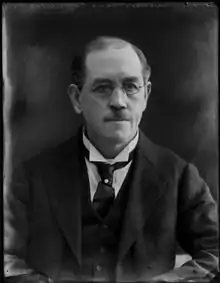
| Party | Candidate | Votes | % | ±% | |
|---|---|---|---|---|---|
| Unionist | Ellis Hume-Williams | 10,419 | 42.3 | −12.9 | |
| Liberal | Arthur Neal | 7,247 | 29.4 | New | |
| Labour | Malcolm MacDonald | 6,973 | 28.3 | −16.5 | |
| Majority | 3,172 | 12.9 | +2.5 | ||
| Turnout | 24,639 | 76.6 | +2.2 | ||
| Unionist hold | Swing | N/A | |||
| Party | Candidate | Votes | % | ±% | |
|---|---|---|---|---|---|
| Unionist | Ellis Hume-Williams | 12,944 | 55.2 | N/A | |
| Labour | Henry Joseph Odell | 10,502 | 44.8 | New | |
| Majority | 2,442 | 10.4 | N/A | ||
| Turnout | 23,446 | 74.4 | N/A | ||
| Unionist hold | Swing | N/A | |||
Election in the 1910s
| Party | Candidate | Votes | % | ±% | |
|---|---|---|---|---|---|
| C | Unionist | Ellis Hume-Williams | Unopposed | ||
| Unionist hold | |||||
| C indicates candidate endorsed by the coalition government. | |||||
General Election 1914/15:
Another General Election was required to take place before the end of 1915. The political parties had been making preparations for an election to take place and by the July 1914, the following candidates had been selected;
- Unionist: Ellis Hume-Williams
- Liberal:
| Party | Candidate | Votes | % | ±% | |
|---|---|---|---|---|---|
| Conservative | Ellis Hume-Williams | 5,436 | 51.0 | −0.6 | |
| Liberal | Stopford Brooke | 5,221 | 49.0 | +0.6 | |
| Majority | 215 | 2.0 | −1.2 | ||
| Turnout | 10,657 | 88.7 | −2.2 | ||
| Conservative hold | Swing | −0.6 | |||
| Party | Candidate | Votes | % | ±% | |
|---|---|---|---|---|---|
| Conservative | Ellis Hume-Williams | 5,631 | 51.6 | +4.2 | |
| Liberal | Frank Newnes | 5,290 | 48.4 | −4.2 | |
| Majority | 341 | 3.2 | 8.4 | ||
| Turnout | 10,921 | 90.9 | +0.8 | ||
| Conservative gain from Liberal | Swing | +4.2 | |||
Elections in the 1900s

| Party | Candidate | Votes | % | ±% | |
|---|---|---|---|---|---|
| Liberal | Frank Newnes | 5,365 | 52.6 | New | |
| Conservative | Frederick Milner | 4,834 | 47.4 | N/A | |
| Majority | 531 | 5.2 | N/A | ||
| Turnout | 10,199 | 90.1 | N/A | ||
| Registered electors | 11,320 | ||||
| Liberal gain from Conservative | Swing | N/A | |||
| Party | Candidate | Votes | % | ±% | |
|---|---|---|---|---|---|
| Conservative | Frederick Milner | Unopposed | |||
| Conservative hold | |||||
Elections in the 1890s
| Party | Candidate | Votes | % | ±% | |
|---|---|---|---|---|---|
| Conservative | Frederick Milner | 4,874 | 57.4 | +5.0 | |
| Liberal | Robert Eadon Leader | 3,621 | 42.6 | −5.0 | |
| Majority | 1,253 | 14.8 | +10.0 | ||
| Turnout | 8,495 | 85.0 | −3.4 | ||
| Registered electors | 9,990 | ||||
| Conservative hold | Swing | +5.0 | |||
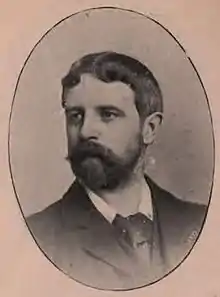
| Party | Candidate | Votes | % | ±% | |
|---|---|---|---|---|---|
| Conservative | Frederick Milner | 4,446 | 52.4 | N/A | |
| Liberal | James Yoxall | 4,044 | 47.6 | N/A | |
| Majority | 402 | 4.8 | N/A | ||
| Turnout | 8,490 | 88.4 | N/A | ||
| Registered electors | 9,606 | ||||
| Conservative hold | Swing | N/A | |||
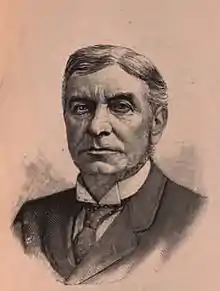
| Party | Candidate | Votes | % | ±% | |
|---|---|---|---|---|---|
| Conservative | Frederick Milner | 4,381 | 54.5 | N/A | |
| Liberal | John William Mellor | 3,653 | 45.5 | New | |
| Majority | 728 | 9.0 | N/A | ||
| Turnout | 8,034 | 78.2 | N/A | ||
| Registered electors | 10,268 | ||||
| Conservative hold | Swing | N/A | |||
Elections in the 1880s
| Party | Candidate | Votes | % | ±% | |
|---|---|---|---|---|---|
| Conservative | William Beckett-Denison | Unopposed | |||
| Conservative hold | |||||
| Party | Candidate | Votes | % | ±% | |
|---|---|---|---|---|---|
| Conservative | William Beckett-Denison | 4,367 | 51.7 | ||
| Liberal | Francis Foljambe | 4,072 | 48.3 | ||
| Majority | 295 | 3.4 | |||
| Turnout | 8,439 | 89.0 | |||
| Registered electors | 9,479 | ||||
| Conservative win (new seat) | |||||
Notes and references
- Notes
- A county constituency (for the purposes of election expenses and type of returning officer)
- As with all constituencies, the constituency elects one Member of Parliament (MP) by the first past the post system of election at least every five years.
- References
- "Usual Resident Population, 2011". Neighbourhood Statistics. Office for National Statistics. Retrieved 28 January 2015.
- "Electorate Figures - Boundary Commission for England". 2011 Electorate Figures. Boundary Commission for England. 4 March 2011. Archived from the original on 6 November 2010. Retrieved 13 March 2011.
- "Labour's John Mann quits as MP to join House of Lords". BBC News. 28 October 2019. Retrieved 28 October 2019.
- "Sally Gimson: Bassetlaw Labour candidate deselected by NEC". BBC News. 6 November 2019. Archived from the original on 8 February 2020. Retrieved 8 February 2020.
- "Deselected Bassetlaw candidate Sally Gimson drops legal fight". BBC News. 9 November 2019. Archived from the original on 8 February 2020. Retrieved 8 February 2020.
- McAllister, Richard (13 November 2019). "New Labour MP candidate announced after selection row". Lincolnshire Echo. Archived from the original on 8 February 2020. Retrieved 8 February 2020.
- Wright, Mike (13 December 2019). "Conservatives take Bassetlaw with biggest swing of night - ending 90 years of Labour dominance". The Daily Telegraph. Archived from the original on 8 February 2020. Retrieved 8 February 2020.
- The Times Guide to the House of Commons 2019. Glasgow: Times Books. 2020. p. 55. ISBN 978-0-00-839258-1.
- Leigh Rayment's Historical List of MPs – Constituencies beginning with "B" (part 1)
- "Bassetlaw Parliamentary constituency". BBC News. Retrieved 22 November 2019.
- "STATEMENT OF PERSONS NOMINATED" (PDF). Bassetlaw District Council. Archived from the original (PDF) on 28 February 2018. Retrieved 13 May 2017.
- "Election Data 2015". Electoral Calculus. Archived from the original on 17 October 2015. Retrieved 17 October 2015.
- "Election Data 2010". Electoral Calculus. Archived from the original on 26 July 2013. Retrieved 17 October 2015.
- "Election Data 2005". Electoral Calculus. Archived from the original on 15 October 2011. Retrieved 18 October 2015.
- "Election Data 2001". Electoral Calculus. Archived from the original on 15 October 2011. Retrieved 18 October 2015.
- "Election Data 1997". Electoral Calculus. Archived from the original on 15 October 2011. Retrieved 18 October 2015.
- "Election Data 1992". Electoral Calculus. Archived from the original on 15 October 2011. Retrieved 18 October 2015.
- "Politics Resources". Election 1992. Politics Resources. 9 April 1992. Archived from the original on 24 July 2011. Retrieved 6 December 2010.
- "Election Data 1987". Electoral Calculus. Archived from the original on 15 October 2011. Retrieved 18 October 2015.
- "Election Data 1983". Electoral Calculus. Archived from the original on 15 October 2011. Retrieved 18 October 2015.
- British Parliamentary Election Results 1918-1949, FWS Craig
- Debrett's House of Commons & Judicial Bench, 1916
- British Parliamentary Election Results 1885-1918, FWS Craig
- The Liberal Year Book, 1907
- Debrett's House of Commons & Judicial Bench, 1901
- "Election Intelligence, Nottinghamshire (Bassetlaw Division): Result of the Poll". The Times. 17 December 1890.
- The Constitutional Year Book, 1904, published by Conservative Central Office, page 151 (175 in web page)
- Debrett's House of Commons & Judicial Bench, 1886
Sources
- UK General Election 1945 results
- UK General Election 1950 results
- UK General Election 1951 results
- UK General Election 1955 results
- UK General Election 1959 results
- UK General Election 1964 results
- UK General Election 1966 results
- UK General Election 1970 results
- UK General Election February 1974 results
- UK General Election October 1974 results
- UK General Election 1979 results
- UK General Election 1983 results
- UK General Election 1987 results
- UK General Election 1992 results
- UK General Election 1997 results
- UK General Election 2001 results
- UK General Election 2005 results
- UK General Election 2010 results (BBC)
